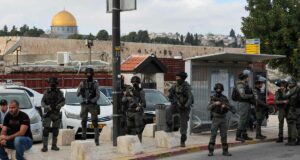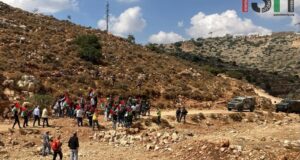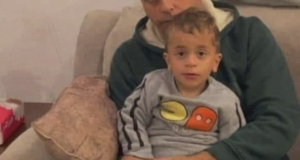10 July 2010
Al-Ma’sara: tearing down the wall

Al Ma'sara residents destroy a fake wall. Photo: Kara
The Popular Committee of Al Mas’ara supported by a number of Internationals and Israelis constructed and then demolished a symbolic wall to mark the sixth anniversary of the decision by the International Court of Justice that Israel’s Apartheid Wall is illegal.
After afternoon prayers the villagers and internationals gathered to march towards the the illegal Israeli settlements that encroach on Palestinian land, while chanting “The wall must fall”. They set up the Styrofoam wall at the intersection of roads 356 and road 3157 which link these settlements to Jerusalem and each other. Though Palestinians can at present use the road to get to Ramallah, Israel soon plans to block Palestinian access, making it a settlers-only road, explained Mahmoud Zahwre of the Al Ma’sara Popular Committee .
The makeshift wall blocked traffic and Israeli army jeeps arrived and tried to intervene in the protest, telling demonstrators that they were in a closed military zone and must leave, but without success. Speeches were held in Arabic and English calling for an end to the occupation and the continuation of the struggle for peace and justice. The demonstration culminated in the destruction of the Styrofoam wall by protestors.
This fake wall measured four meters wide and demonstrators who tore it down said they were implementing the decision of the International Court of Justice. The actual wall that Israel continues to build despite the ruling of the ICJ will be some 760 km when completed and already illegally annexes huge swathes of the West Bank.
The popular committee of Al Ma’sara was established in November 2006 and has held weekly nonviolent demonstrations since that time.
Bili’in: the scales of justice

Bilin villagers carry scales labelled Israel and World
This Friday, as usual, the village of Bil’in held its weekly protest against the Apartheid Wall and the illegal occupation. Bil’in has had 70% of its farm land annexed by the wall and an expansion of the large illegal settlement Modi’in Illit – and the village has for that reason become one of the main sites of the Palestinian resistance. This particular Friday was also the 6th year anniversary of the verdict of the International Court of Justice that the wall is illegal and must be removed – a verdict that has yet to be enforced.
Approximately two hundred locals and internationals participated in the non-violent action. The Israeli army responded by raining tear gas down on protestors from two directions – causing one young Palestinian to collapse and lose consciousness for some minutes due to inhalation. Nineteen year old Taher from Tulkarm who was visiting Bili’in with the Freedom Theatre group, had to be carried by locals back towards the village and away form the wall which was the target of the protest. There were cheers when he eventually came to. Last year Bili’in resident Basem Abu Rahma was killed by soldiers who shot a high-velocity tear gas canister directly at him.
Bil’in protests, over 300 of which have been held in the last 5 years, are known for their imaginative and highly visual demonstration props, and this Friday was no exception, as the protest was dominated by an enormous weighing scale carrying signs saying “Israel” on one side and “The World” on the other to symbolize the imbalance of Israel’s power compared to the rest of the world. The scale was planted in a fake coffin with the inscription “International Law – RIP” as an unmistakably clear comment on the Israeli government’s disregard of the verdict of the ICJ on the wall as well as its flouting of a number of other international laws, according to which the occupation and the West Bank settlements it continued to expand are wholly illegal.

A teenager lost consciousness after inhaling tear-gas
As the demonstration approached the wall, Israeli soldiers from behind the fence fired repeated volleys of tear gas at the non-violent protestors, with some of cannisters setting the dry grass on fire, endangering the olive trees. Many of the young locals kept returning to the fence, despite the tear gas bombardment. Some threw stones over the wall, where their farm land used to be. The response of the Israeli army was typically disproportionate but since no arrests were made the protest ended in high spirits.
An Nabi Saleh: the struggle continues
In the hilltop village of An Nabi Saleh around 70 Palestinian men, women and children, 10 Israeli activists and 15 internationals gathered in the main square and marched down the hill, blowing paper trumpets and waving flags, towards the Israeli soldiers who were waiting at the crossroads, where the main protest usually occurs. Following last weekend, when soldiers entered the village dressed as civilians and arrested one of the young men, many of the local youth were lying low and did not join in the demonstration.
When the group were about 10 metres away, the soldiers started throwing sound bombs, and tear gas canisters were fired directly at the group at head height. Although this is against their rules of deployment, tear gas canisters are regularly used as missiles as well as for crowd dispersal. Two internationals narrowly missed being hit, and a member of the popular committee was arrested, and his wife and four-year-old child briefly detained. Some of the demonstrators made it to the crossroads and the group (mainly women and children) stood chanting at the soldiers. Two Israeli activists were grabbed from the crowd and wrestled into jeeps, amid scuffles with female activists who were roughly pushed away by soldiers.
The demonstration continued around the village for a few hours, as soldiers and border police in five jeeps pursued the young men around the area in an attempt to arrest those they had pictures of. Their presence in the village lasted for just two hours, as the usual spirit of the children and women had been dampened by the violent repressive tactics of the Israeli army, and the young men had fled over the hills towards a neighbouring village. The three men who had been arrested were released after three hours.
Protests against the theft and annexation of Palestinian land to the illegal Israeli settlement of Halamish (Neve Zuf) have taken place in the village every Friday since January 2010. Although Israel’s courts ruling that An Nabi Saleh residents owned the valuable agricultural land, nearly half of it has been seized by settlers who also uprooted hundreds of olive trees in January 2010.
Ni’lin: army repression fails to deter protest
A group of around 75 people – locals and internationals – marched on the Apartheid Wall in Ni’lin yesterday for the village’s weekly protest. When demonstrators reached the Wall, the Israeli army – who since May 2008 have killed five people in the village and critically injured one American solidarity activist – fired multiple volleys of tear gas, forcing the protesters to run for cover. This was then followed by incursions by Israeli soldiers onto the Palestinian side of the wall; they pursued fleeing protesters across the hilly terrain, intermittently firing tear gas at them. This week the army did not capture or injure anyone and refrained from storming the village. In the past they have used tear-gas projectiles, rubber coated steel bullets and live ammunition.
Since May 2008, a total of 112 Ni’lin residents have been arrested in relation to anti-Wall protest in the village. Constituting nearly 10% of the male population of Ni’lin aged between 12 and 55, the arrests are part of Israel’s campaign to suppress grassroots opposition to the wall. As a result of the Wall construction, Ni’lin has lost 3,920 dunams, roughly 30% of its remaining lands, and due to illegal settlement building is nowadays only 56% of its original size. Ni’lin is sliced in half by Road 446, which was built directly through the village. According to Israeli government plans, this will be made into a segregated setter-only road and Palestinian access and freedom of movement severely restricted as a result.
Ni’lin presents yet another example of Israel’s disregard of the rule of law. As well as the International Court of Justice ruling the wall illegal almost exactly six years ago today, Israel’s own Supreme Court issued an injunction in 2004 briefly halting construction of the wall, and subsequently rejecting a second proposed route as equally illegal. However it resumed again in May 2008 and since then Ni’lin residents have staged regular demonstrations calling for Israel to respect its own and international laws.
 International Solidarity Movement Nonviolence. Justice. Freedom.
International Solidarity Movement Nonviolence. Justice. Freedom.


